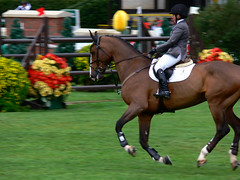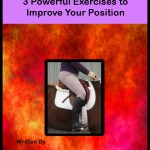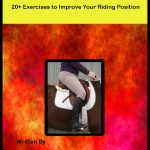Horse Training – Is Your Horse Tense?
Is your horse tense? Do you know when your horse is traveling correctly? How do you tell?

When the horse is moving comfortably and correctly, the poll should and needs to be presented as the highest point within the ‘arc’ of the neck.
It matters not if the horse is on a long rein or in a form of collection; the poll should be highest point.
Sadly, the highest point commonly results not at the poll but at the 2nd, 3rd or 4th cervical vertebrae.
Sadly, the highest point commonly results not at the poll but at the 2nd, 3rd or 4th cervical vertebrae. When the horse is tense this interferes with the horse’s way of going.
What Happpens if Your Horse is Tense?
Poll tension around the 2nd cervical vertebrae corresponds to a hormone acupressure check point associated with feelings of unease and sensitivity to noise, thus the horses’ character traits may well adjust accordingly.

Poll tension is influential to the horses’ inability to work in a true outline, and, when he does not work in the desired outline, the very causes’ of the problem commonly compound the problem by being used as a solution to the problem they created.
The horse adapts compensatory locomotion, demonstrated through a restricted shoulder action, high head carriage and hollow back with its’ own consequences, not limited to development of a bottom line rather than a topline, often seeing the weaker topline promoting intercostal muscular stress, in turn affecting respiration.
The horse may well present difficultly working equally on either rein, seeing him ‘fall in’ or struggle to take off on a jump from a specific direction as well as losing rhythm presenting disunited gates. Causes of poll tension are often linked to a restricted jaw and forehead tension; commonly feeding off one another in a negative cycle.
Causes of Tension
Some of the most common causes of poll tension are not limited to:
- teeth in a poor state of health,
- rider habits,
- not enough grazing,
- previous injury to the head or jaw,
- forehead tension,
- inappropriate or incorrectly used tack such as the martingale, pelham or curb bit,
- stressed cervical fascia tissue or stressed nuchal ligament to name a few.
Some of the most common behavioural signs indicative to poll tension are most obviously:
- negative reactions to any interaction with the horse’s head for any reason,
- to the not so obvious behaviours such as avoidance of objects on the ground,
- problems with depth perception,
- resistance to sunlight,
- hesitation moving from light to dark or vice versa,
- sensitivity to noise,rearing,
- napping,
- opening the mouth or clenching the jaw to relieve resultant jaw tension.
Physical consequences from poll tension include immediate muscular stress through the neck, back and shoulders with referred muscular stress radiating through the body, cold ears, jaw and limbs, floppy lower lip, digestive and respiratory difficulties and stumbling, to name but a few.
Once realised, poll tension is rarely a solitary problem but one problem within a cycle of muscular, physical and emotional entanglements.
Article Source: http://EzineArticles.com/?expert=Roberta_Adams
43VPKP573T2N





 Try these three powerful exercises to get strengthen your position.
Try these three powerful exercises to get strengthen your position.

One thought on “Horse Training – Is Your Horse Tense?”
Comments are closed.